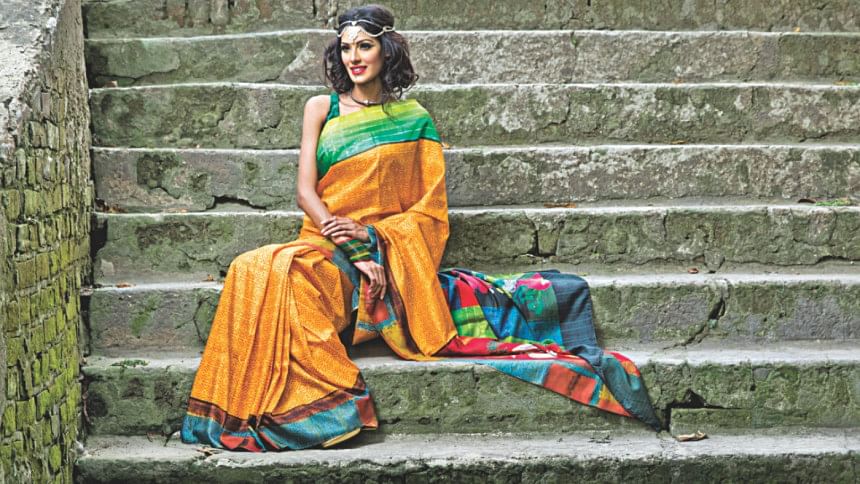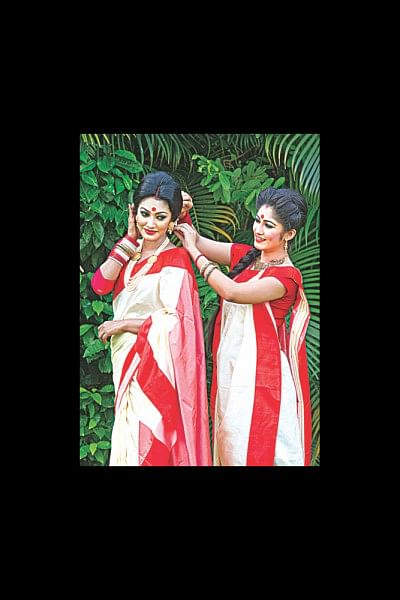The colours of our lives

The paper lanterns keep flying higher, and higher still; the flame beneath, propelling the 'phanush' creating a mesmerising display of colours in the sky - a fiery burst of yellow, seen through the translucent mesh of thin coloured papers.
A fleet of kites fly by manoeuvring through the lanterns as the able hands of flyers engage in a battle for the bounty – a prized kite of the person on the next rooftop.
While the battle draws to an end as the last day of Poush phases out with the sunset, the festivity of Sankranti is yet to be over. Fire breathers take centre stage and engage in a battle for supremacy. As Shakhari Bazaar celebrates Shakraine, people of Dhaka join in. In the new Gregorian calendar year, this is the beginning of the expressions of colours in our lives.

All yellow…and maybe some orange
Winter rolls onto spring and the waves of yellow from expansive fields of mustard blossoms spreads even to the sedentary urban setting, bringing about a much needed respite from the ever decreasing, yet harsh, days of winter.
The grey patches meet an overpowering force within us; the liveliness of marigolds that bloom in pots and flowerbeds is as if emanating off the moistened brush of an artist. The bedazzled cuckoo, the songster for the season, coos in search of its mate.
At Charukala's Bakultala, thousands throng the premises welcoming spring with open arms. They are dressed in softer shades of yellow to the brightest spectrum of orange - no more so aggressive and passionate as red, but as an emotional stimulant. Like yellow, orange reflects warmth, generosity; it is light and playful, and the fusion of these two shades makes a unique expression celebrating the coming of spring.
Red all over
Boishakh - days when the dazzling sun shows no sign of mercy to the mortals on earth; a time when the tarmac roads of Dhaka melt in the blazing heat, and still the time when fiery red encapsulate everything around– it's now a time to celebrate the coming of the new Bengali year! Red is the colour of blood and fire, and is associated with passion and desire.
It would be hard to pin point the exact time in our history when red begun to symbolise the vitality of life, but representation of Pohela Boishakh through fiery shades of red has been a time long one.
Remniscent of some of the oldest Krishnochuras in the capital blooming in, fashionistas borrow the red from the flames of the forest onto the borders of their saris. Not unlike spring, the colours of Boishakh are taken from the hues of nature.
Perhaps the coming of Boishakh has now emerged as the quintessential Bengali expression. Although its root can be traced in the annals of history, the modern day observance has been as much of a symbol of defiance against tyranny and a celebration of creed than anything else. The colourful Mongol Shobhajatra brought out by students of Charukola has recently been acknowledged as a cultural representation of Bengali lives. Although a new addition to the festivities, the theme and the importance of such endeavours now define what it means to be a Bengali!

The colours of her kind
Poet and bards romance the Bengali belle in blue. For Dhakaiites, monsoon brings incessant rain and waterlogged roads, yet for the hopeless romantics it is the ultimate season for love and lovemaking.
Blue represent aqua – the vitality of all life forms. Maybe because of the seemingly endless expanse of water in the ocean or the canopy of the azure sky, the colour is symbolic to infinity and notions of affection and fondness.
Human expression knows no bounds. Although the cynics will disagree, as they always do, monsoon is dear in our Bengali lives, despite the nuisance. This is also the colour that brings us closest to nature, second only to green.
Shades of purity
White is the colour of clarity, to which we respond with positivity. It also symbolises innocence and purity - a new beginning, and rebirth. Autumn in Dhaka is a season of glum, yet out in the outback, the clouds move about in a clear sky, creating a mesmerising image. From the distance, the kaash seems like a stretch of white carpet. As the wind blows, the tall kans grass bows in harmony, often spreading the cotton-like, pulp in the air.

Red, green and everything in between
Red and green, in a nut-shell, defines Bangladeshis. The green is quintessential Bengal - a lush land with trees growing in abundance, the field yielding crops and the harvest enough to sustain life. The red represents our struggle to achieve such a blissful setting.
As a civilisation, we have experienced trauma as we have experienced joy, and to each of these emotions we respond. The sombre Ekushey, which was once a day marked for the loss of our brethrens, is now observed as a salutation to the rich diversity in languages both within Bangladesh and across the world.
Language binds humanity in one string, each pearl representing a culture and the ultimate rosary representing the richness of human expressions. The shades of Ekushey have not eclipsed the mourning black, but somewhat made way for a subtle shade of grey. While we still mourn the loss of lives, we also cherish and pay homage to what their sacrifice has given us.
As the cycle of seasons draws to an end, the changing hues in our lives take new forms. In our Bangladeshi existence, there are colours in our lives taken, borrowed or hinted from the world around us; and then there are colours from our lives – shared with fellow countrymen from our collective experiences - the joys, trauma, and pain we share. Colours define our existence and we can safely hope, will continue to do for years to come.
The writer is a sub-editor working for The Daily Star. He can be contacted at [email protected]
Photo: LS Archive

 For all latest news, follow The Daily Star's Google News channel.
For all latest news, follow The Daily Star's Google News channel. 


Comments